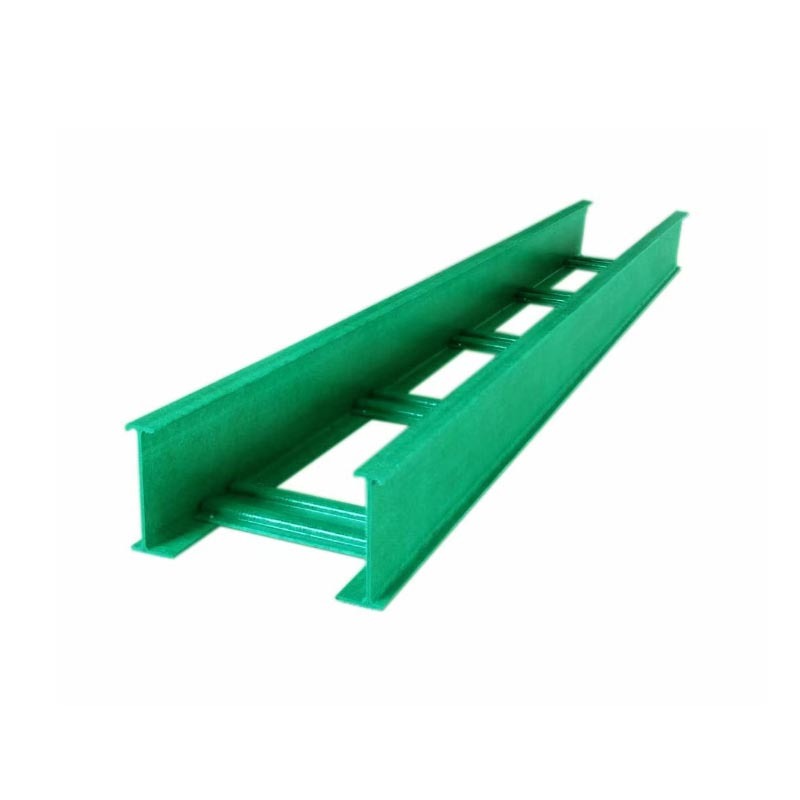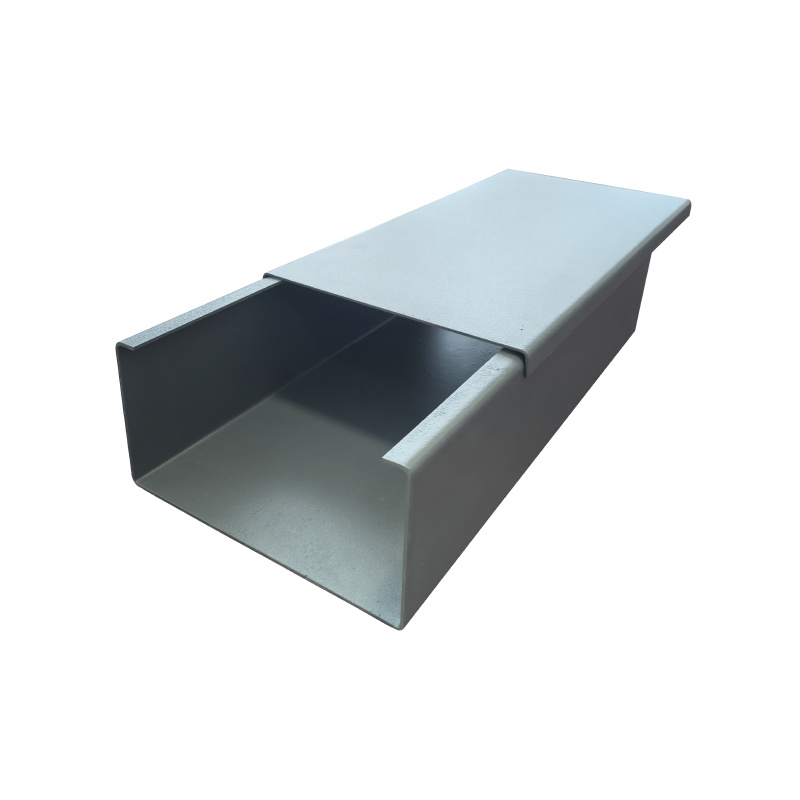






Share
Composite cable tray (lined with steel plate)
Still hesitating? Get a sample first and contact us!
- Product Description
-
Structure and Material
Structural design
● A layered structure is usually used, consisting of protective layer, fireproof layer, anti-corrosion layer, protective layer, etc. from the outside to the inside, and each layer is tightly bonded together through compression molding.
Material composition
● Epoxy resin: As the main matrix material, it has good adhesion, corrosion resistance, and insulation properties, which can firmly bond various layers of materials together while providing basic protection and electrical insulation functions.
● Glass fiber: commonly used as a reinforcing material in the form of glass fiber cloth or glass fiber felt, when combined with epoxy resin, can significantly improve the mechanical strength and toughness of the bridge frame, enabling it to withstand large loads and external impacts.
● Metal skeleton: generally made of cold-rolled steel plate, with the same shape as the cable tray section, and the thickness varies according to the tray specifications, usually between 1.5-2.0mm. The metal skeleton provides additional rigid support for the cable tray, enhancing its load-bearing capacity and enabling it to span larger distances and support large-diameter cables.
● Fillers: mainly including aluminum hydroxide, flame retardants, etc. Aluminum hydroxide has the characteristics of lightweight and flame retardancy, which can reduce the weight of the bridge itself, improve the flame retardancy of the bridge, and also play a role in flame retardancy and smoke suppression in the event of a fire, preventing the spread of flames.

Characteristic
● Superior anti-corrosion performance: It has good resistance to various corrosive media such as acid, alkali, salt, ammonia, etc. In harsh chemical environments, its service life can reach more than 30 years, and it is not easy to cause corrosion, rust and other problems. It can effectively protect cables from the damage of corrosive media.
● High mechanical strength: Combining the rigidity of metal skeleton and the toughness of epoxy resin fiberglass, it has both the strength of metal bridge and the flexibility of fiberglass bridge. Its tensile and bending strength can reach over 600pa, and its fatigue resistance is strong, about 50 times that of steel. It can carry large-diameter cables, with a bridge span of up to 15 meters, and can withstand large loads and external impacts.
● Good fire resistance: flame retardant oxygen index not less than 30%, self extinguishing, and not easy to burn. In the event of a fire, it can slow down the spread of the fire, buy time for personnel evacuation and firefighting rescue, and protect cables to remain unobstructed for a certain period of time, ensuring the normal operation of power and communication systems.
● Strong anti-aging performance: the protective layer with special functions such as anti light is molded on the surface of the bridge, which can effectively block ultraviolet radiation and slow down the aging speed of materials. Even if exposed to outdoor environment for a long time, it is not easy to crack, fade, powdery and other aging phenomena, with a long service life.
● Excellent insulation performance: Materials such as epoxy resin and glass fiber have good insulation performance, which can effectively prevent electrical accidents such as leakage and short circuits, avoid the formation of closed circuits between magnetic fields and cable trays, and ensure the safe operation of cable systems.● Beautiful appearance and easy installation: The surface is smooth and flat, with a beautiful appearance that can coordinate with the surrounding environment. Moreover, it is relatively lightweight and the installation process is simple and fast, which can greatly shorten the construction period and reduce labor intensity.
Application Area
● Chemical industry: Various corrosive media are often present in the chemical production process. The excellent anti-corrosion performance of composite epoxy cable trays enables them to be widely used in chemical plants, warehouses, tank areas, and other places, providing reliable support and protection for cables in chemical production.
● Metallurgical industry: The production environment of metallurgical enterprises is usually harsh, with factors such as high temperature, dust, and corrosive gases. Composite epoxy cable trays have good mechanical strength and anti-corrosion performance, and can adapt to complex working conditions in the metallurgical industry. They are used for laying power cables, control cables, communication cables, etc.
● Power industry: In power facilities such as power plants, substations, and distribution rooms, composite epoxy cable trays can be used for laying cables of different voltage levels, which can meet the support, protection, and fire prevention requirements of power cables and ensure the safe and stable operation of the power system.
● Petroleum industry: There are hazardous environments that are flammable and explosive in the processes of oil extraction, refining, and storage. The fire and corrosion resistance of composite epoxy cable trays make them an ideal choice for cable laying in the petroleum industry, and can be applied to oil well platforms, refineries, oil depots, and other places.
● Municipal engineering: In urban facilities such as subways, tunnels, and cable trenches, composite epoxy cable trays can centrally manage and protect cables, facilitating maintenance and repair. At the same time, their beautiful appearance also helps to enhance the overall image of urban infrastructure.
Key points of installation
● Preparation before installation: Check whether the specifications, models, and quantities of the cable tray meet the design requirements, and whether there are any defects such as damage or deformation in the appearance. Count and classify the various components of the bridge frame, and prepare the necessary tools and materials for installation, such as bolts, nuts, washers, wrenches, drills, etc.
● Installation of support and hanger: Determine the installation spacing and position of support and hanger according to the installation position and design requirements of the bridge. The short span of indoor supports and hangers is generally 1.5-3m, and the span of outdoor columns is generally 6m. The support and hanger should be installed firmly, and the horizontal and vertical deviations should meet the requirements of specification.
● Bridge connection: Special connectors such as connecting plates and bolts should be used to connect the bridges. The connecting bolts should be made of stainless steel material to prevent rust and corrosion. When connecting, ensure that the interface of the bridge is flat and aligned, and the tightening force of the bolts should be uniform to avoid looseness or gaps.
● Cable laying: After the installation of the cable tray is completed, the cable laying work is carried out. When laying cables, attention should be paid to the bending radius and filling rate of the cables to avoid excessive tension, compression, or damage. At the same time, the cables should be arranged and fixed according to the design requirements to ensure that the cables are neat and orderly.
Maintenance
● Regular inspection: Regularly inspect the cable tray to see if there is any damage, deformation, corrosion, etc. on the appearance of the tray, whether the connectors are loose, and whether the supports and hangers are firm. If any problems are found, they should be repaired or replaced in a timely manner.
● Cleaning and maintenance: Use a clean soft cloth to regularly wipe the dust and dirt on the surface of the bridge to keep it clean. Avoid using hard objects or corrosive cleaning agents to wipe the bridge, in order to avoid damaging the protective layer 4 on the surface of the bridge.
● Anti corrosion treatment: For areas with slight corrosion, anti-corrosion treatment can be carried out, such as applying anti-corrosion paint or anti-corrosion glue. For severely corroded areas, damaged bridge components should be replaced promptly.
Composite cable tray (lined with steel plate)
Still hesitating? Get a sample first and contact us!
Product Inquiry
Note: We will contact you within one working day, please pay attention to your email.










